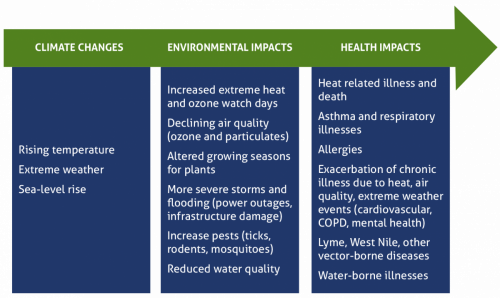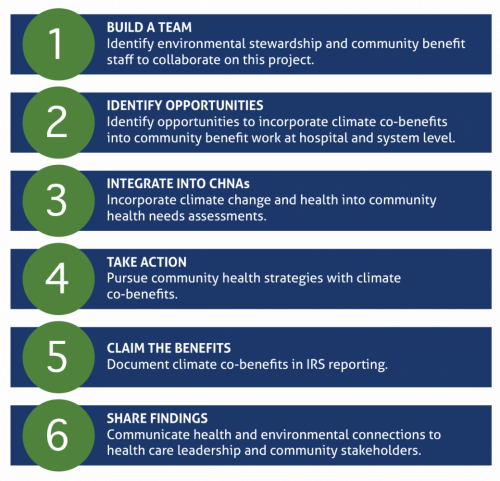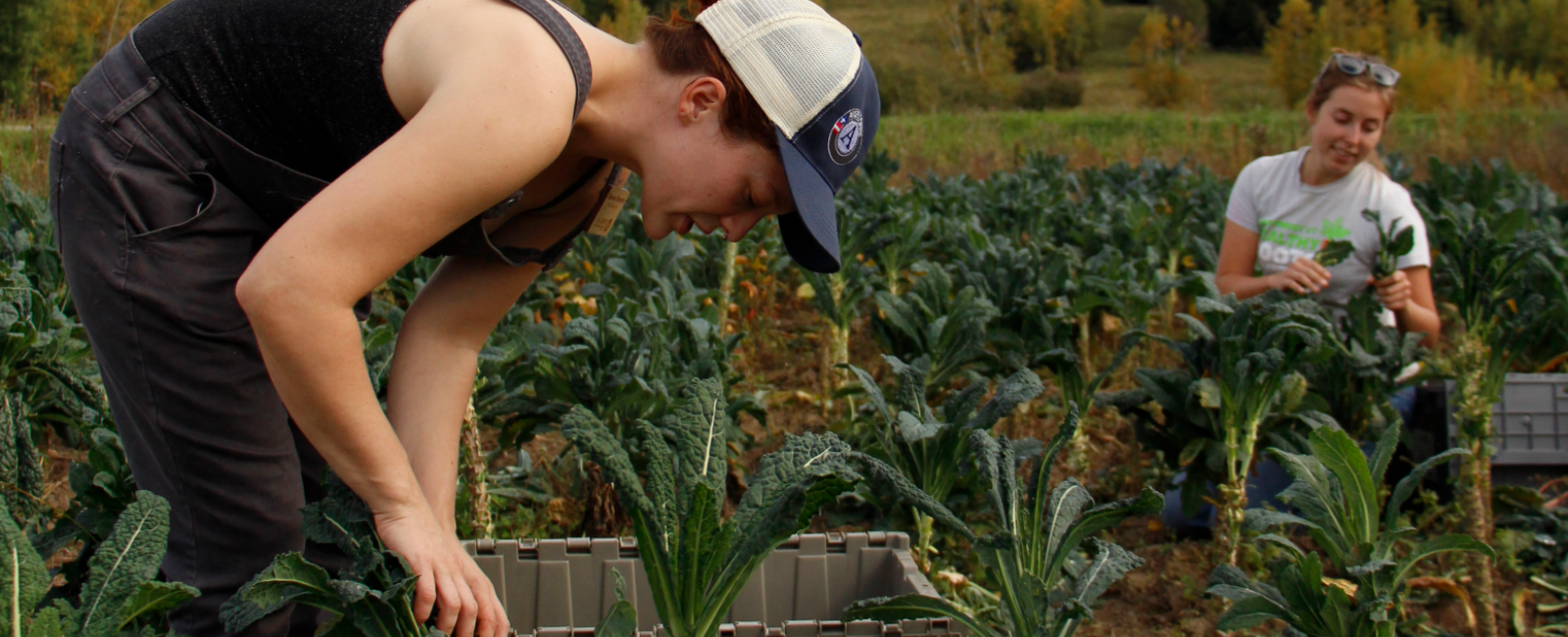Climate co-benefits of healthy food access interventions
Takeaways
This issue brief provides an introduction to bringing climate risks into the community health needs assessment process and identifying valuable climate co-benefits of new or existing food-related initiatives in the community benefit implementation strategy.
- By aligning environmental stewardship activities at the hospital with community health activities, there is a tremendous opportunity to amplify impact.
- Food is a natural touchpoint as it has easily understood health and environmental impacts.
- Environmental stewardship leads at the hospital can often provide relevant data and expertise that can help inform a CHNA and maximize data collection resources.
Why consider bringing climate into community health needs assessments and implementation strategies?
The Delivering community benefit: Climate and health toolkit (available at Practice Greenhealth) is a practical guide to help environmental stewardship leads at health care facilities introduce the vital relationship between climate and health to their community benefit colleagues. It introduces tools and resources to help community benefit staff understand climate-related health risks in their communities, integrate climate and health into the community health needs assessment process (CHNA), and identify current projects that have climate co-benefits.
— Caron Lanouette, Community Benefit Consulting
Climate co-benefits
Climate co-benefits occur when community health improvement initiatives also reduce transportation emissions, fossil fuel use, and other greenhouse gas emissions.
A changing climate creates significant health and financial risks
- Climate change affects the social and environmental determinants of health – clean air, safe drinking water, sufficient food, and secure shelter. Globally, the World Health Organization estimates that climate-change-related deaths already exceed 150,000 per year.
- Health care systems are already experiencing the health impacts of climate change in their communities: increases in heat-related illness, asthma and respiratory disease, insect-borne diseases, and injuries and premature deaths from extreme weather events and sea level rise.
- Physician surveys conducted by researchers at George Mason University’s Center for Climate Change Communication found that over 70 percent of doctors recognize that climate is affecting the health of their patients.
- When Hurricane Irene hit, North Shore-Long Island Jewish health system incurred an estimated $13 million in cost associated with the event — $4 million for labor and supplies and $9 million in revenue lost from hospital closures.

The community health needs assessment process provides a unique opportunity for hospitals to align their environmental and community health goals for mutual benefit. Collaboration between environmental stewardship staff and community benefit staff in this work can drive “climate co-benefit” initiatives that directly improve public health while at the same time reduce greenhouse gas (GHG) emissions.1
Align environmental stewardship and community health activities to amplify impact
Many health care system staff — especially those working in environmental stewardship, facilities management, and procurement departments — are pursuing activities to reduce their environmental footprint. At the same time, community benefit staff are undertaking community health activities to address priorities identified in their CHNAs. By working together, these groups can share expertise and resources to more effectively — and simultaneously — address environmental and health goals.
For example, hospital procurement staff who have expertise in developing local supply chains and integrating sustainably grown food into hospital meal systems could help other community meals programs access these products and thereby reduce their environmental impact.
Facilities and human resources staff with behavior change expertise could help community partners to promote plant-based meals and encourage residents to walk, bike, or take public transportation to work.
- Richard Beam, Providence St. Joseph Health chief environmental officer
- Dora Barilla, Providence St Joseph Health executive leader, community investment,

Integrate into the community health needs assessment
The community health needs assessment process offers an ideal opportunity to draw connections between climate and health. Review recent CHNAs to determine if and how climate risks were considered:
- Did our CHNA consider climate risks?
- Could the current health priorities be exacerbated by climate risks?
- Could our community health activities generate climate co-benefits?
- Are there opportunities to align the community health work with broader system climate goals and projects?
Review and choose tools that can help identify the specific current and future climate threats to your particular community:
- The Delivering Community Benefit: Climate and health toolkit includes a worksheet.
- FourTwentySeven Climate Solutions allows you to create a dashboard of current and future threats.
- The National Assessment on Climate can provide more general impacts.
Craft language identifying climate-related health risks and incorporate it in your facility’s CHNA (see below).
Then, consider strategies to leverage and align community health and climate efforts described in Leveraging Hospital Community Benefit Activities to Address Climate and Environmental Risks. This report outlines examples to maximize climate co-benefits and internal health care system resources when pursuing common health priorities, including those related to food, such as obesity, diabetes, or cardiovascular risks.
University Hospitals in Cleveland, Ohio brought climate and health language to community health needs assessment.
“Climate change and the resulting increases in temperature, air pollution, and extreme weather events will have profound impacts on the health of our population, particularly the most vulnerable (seniors, children, and lower- income).
These changes in our environment will likely exacerbate some of our current health priorities, including obesity, diabetes, cardiovascular risks, respiratory risks, mental health concerns, and violence.
Our community benefit investments are an opportunity to address health priorities using strategies that also reduce greenhouse gas emissions, mitigating the health risks of a changing climate.
University Hospitals will explore such opportunities as we develop our implementation strategies… evaluating future health impacts of climate change in the CHNA process and potentially incorporating climate co-benefit actions into the implementation activities phase of the work offer UH Samaritan Medical Center the opportunity to address these long-term future health impacts using short-term actions.”

Implementation strategies
Many healthy food access programs can have climate co-benefits. For example, hospitals that support community supported agriculture (CSA), farmers markets, community gardens and farms, or fruit and vegetable incentive programs are supporting local and sustainable food production, which uses fewer energy-intensive inputs (such as synthetic fertilizers), thus reducing GHG emissions. Additionally, they are supporting a local food economy which strengthens community resilience and provides economic benefits through supporting local jobs and the community.
Claim the benefits through reporting
Nonprofit hospitals are required to report their community benefit activities to the IRS on their Form 990 Schedule H. Hospitals may report environmental and climate-related actions in several sections of Schedule H:
- In the community benefit category, Community Health Improvement Services (Part I, 7. E): Activities or programs addressing priority health needs identified in the CHNA or in other ways.
- In the community building category (Part II, 4): Activities and programs can include environmental improvements, coalition building, and community health improvement advocacy
- In the Supplemental Information section (Part VI, Line 5): This is an appropriate section to describe activities that promote the health of the community not included elsewhere, such as activities with climate and environmental co-benefits. This is an ideal opportunity to highlight how reduced GHG emissions will mitigate health risks for vulnerable populations most affected by climate change.
See Community benefit tax reporting for healthy food access programs for more recommendations on how to report healthy food access initiatives on Schedule H.
Recommendations for hospital participation
Climate co-benefits
For each of the following examples, the facilities referenced — and other facilities that engage in similar activities — experience the following climate co-benefits:
Emphasizing locally, sustainably grown food and a plant-based diet helps to reduce greenhouse gas (GHG) emissions. Local, sustainable food production can be less energy-intensive and require less transportation, reducing air pollution. Increased plant versus meat consumption reduces methane emissions, a potent GHG.
Kaiser Permanente, Ore. and Wash. (Provide financial support and technical assistance)
Provide financial support and technical assistance for initiatives to increase access to healthy foods in schools and vulnerable communities
![]()
![]() Kaiser Permanente
Kaiser Permanente
Oregon and Southwest Washington
Grant Funding to Community Partners
Kaiser Permanente provided over $1.2 million in grant funds and technical assistance to support increased access to healthier local foods in Oregon and Southwest Washington from 2011-2014.
Kaiser Permanente worked with: 11 school districts to expand procurement of locally produced food, 12 Head Start Centers to serve locally grown fresh produce, one correctional facility to expand its community garden by 56% producing 5,000 lbs. of organic vegetables and herbs per year and to install a greenhouse, 10 CSA farms to offer 75 Supplemental Nutrition Assistance Program (SNAP) paid shares for 300 individuals.
Cleveland Clinic, Ohio (Provide financial and technical assistance)
Provide financial and technical assistance or other support for local, sustainable food businesses
![]()
![]() Cleveland Clinic
Cleveland Clinic
Cleveland, Ohio
Evergreen Cooperatives
In 2008 five Cleveland anchor institutions, including the Cleveland Clinic and University Hospitals, created a local wealth-building and jobs cooperative. The Co-op supports several businesses including Green City Growers, a hydroponic greenhouse producing local food. University Hospital purchases lettuce from Green City Growers along with numerous other businesses and institutions.
Many of Cleveland Clinic’s facilities are sourcing 100% of their lettuce from Evergreen Cooperatives.
Seattle Children’s Hospital, Wash. (Provide grant support to fund produce prescription)
Provide grant support to fund fruit and vegetable incentive vouchers
![]() Seattle Children’s Hospital
Seattle Children’s Hospital
Seattle, Wash.
Fresh Bucks Seattle
Seattle Children’s Hospital offers grant support to fund the city’s fresh produce incentive program.
Fresh Bucks participant surveys found an 88% increase in consumption of fruits and vegetables.
Behavior change surveys found that 89% of participants attributed Fresh Bucks to making a difference in their families diets.
Fresh Bucks coupons contributed $330,607 to local farmers and $591,786 to supporting local economy.
St. Joseph Mercy Ann Arbor Hospital, Mich. (Support the legislative policy initiatives)
Support the legislative policy initiatives of food policy councils
![]() St. Joseph Mercy Ann Arbor Hospital
St. Joseph Mercy Ann Arbor Hospital
Ann Arbor, Mich.
10 Cents a Meal for School Kids & Farms program
St. Joseph Mercy Ann Arbor has a seat on the Washtenaw Food Policy Council, which has joined other local councils to successfully advocate for an expansion of state funding for the 10 Cents a Meal for School Kids & Farms program. This pilot program provides schools with up to 10 cents per meal in match funding to purchase and serve Michigan-grown fruits, vegetables, and legumes.
The 10 Cents a Meal for School Kids & Farms program for the 2016-17 school year impacted 48,000 students in 16 school districts, providing them with 49 different Michigan-grown foods grown by 86 farms.
Learn more
Leveraging Hospital Community Benefit Activities to Address Climate Change and Environmental Risks discusses tracking the climate co-benefits associated with existing community health improvement strategies.
Community Benefit - Impact on Climate Change and the Environment outlines the opportunity that nonprofit hospitals have to connect their community benefit process to climate and health risks.
Climate Change and Health: Is there a role for the health care sector? discusses opportunities for health care to address climate change.
Practice Greenhealth’s executive summary for the Delivering community benefit: Climate and health toolkit outlines steps to get started within your hospital.
